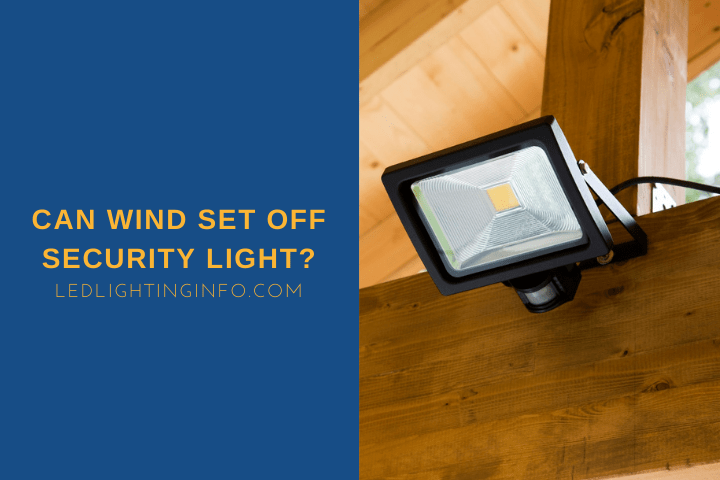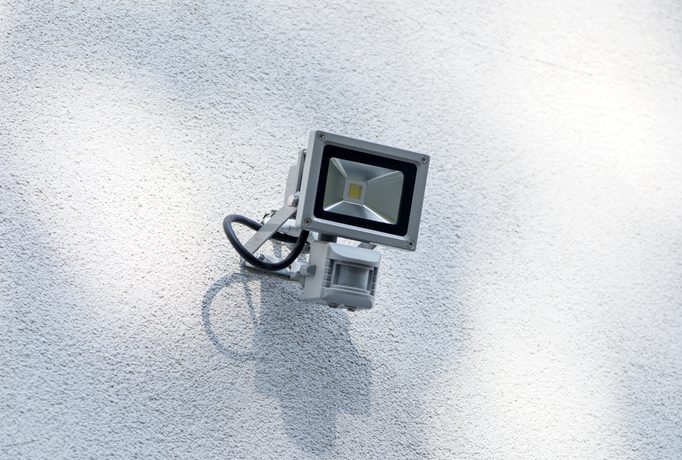Security lights with a built-in motion sensor are a great way to improve the safety of your home.
They help to make sure that your outdoor space is well-lit when you’re using it, and they can help to deter any unwanted intruders from trying to break in.
However, you don’t want a motion sensor that is continually switching on your light.
It uses a lot of energy and will probably be extremely annoying. If not for yourself, then definitely for your neighbors. So, it’s essential to know how sensitive a motion sensor will be.
On its own, the wind won’t trigger the motion sensor of a security light. But it can cause something else to trigger the sensor, mainly if it detects motion through movement and you have tree branches or loose objects in view.
In this article I’m going to take you through:
- How security lights’ motion sensors work
- Why wind doesn’t impact these sensors
- What conditions can set of a sensor due to wind
Are Motion Sensors Triggered By A Heat Signature?

Almost all security lights use some form of sensor to detect movement. However, there are different levels of sophistication, which impact how sensitive the security light is.
The cheapest security lights will work with a basic motion sensor that detects the movement of any object. These are problematic because anything can set them off – heavy rain or snow, moving objects, or swaying branches.
Also, if you’re in the garden and you stop moving, or you’re only moving a small amount, the light may switch off even when you need it. You might have had to jump up and down to get the sensor to detect you again, which is hardly convenient.
Also, sensors have a lifespan – the more they switch on and off, the faster they’ll wear out. A basic motion sensor that is constantly turning on and off will only need to be replaced sooner.
Instead, consider a security light that works using a Passive Infrared sensor (PIR). These detect the infrared heat being given off by objects in the field of view.
When that infrared heat changes because something has moved, it’ll switch the light on.
Some work with all heat changes, regardless of what that heat source is. Others are tailored to human body heat signatures only so that they won’t be triggered by pets.
Often, the best option is an adjustable sensor – one that you can set to your desired level so that the sensor is triggered by dogs or cats if you have problems with strays rummaging through your garbage.
Basic PIR sensor security lights are a little more expensive than basic movement sensor models.
However if you start looking for a light that only triggers based on human movement, or can be adjusted, then your budget may need to be stretched a little further.
Can Wind Set Off A Motion Detector?

In normal conditions, wind alone can’t set off the motion detector. Air doesn’t have an infrared heat signature, so the PIR won’t capture any movement with the wind blowing past.
And basic movement sensors are based on light, so don’t see the invisible air particles’ movement.
So, if your security light switches on during wind, you should check the integrity of the sensor unit attached.
If it’s cracked or loose, this could be the cause – wind directly hitting the exposed sensor unit can cause it to malfunction and give false positives.
If you’ve checked the sensor and it looks fine, but the motion sensor is still being triggered with nothing obvious to see, then it might be that wind is causing more of a chain reaction to make the light switch on.
Also read: Can Laser Pointer Set Off Motion Sensor Lights?
Why Does A Motion Detector Trigger When It’s Windy?
While it’s rare for the wind itself to cause your security light to switch on, it’s often the first step to causing something else to trigger the sensor.
If your security light only has a basic movement sensor, then any large falling objects blown over by the wind, or loose items you’ve left in the garden, could easily cause the sensor to activate as they’re blown around.
One of the most common causes of false activations is tree branches swaying in the wind. In most situations, a tree branch alone won’t matter.
It normally has to show considerable movement to trigger a sensor.
Tree branches could also trigger a PIR sensor in specific scenarios.
That’s more likely if there is a light source behind the tree – a street light, or a neighbor who always leaves the drapes open, for example.
Any light source is going to generate infrared heat. Because it’s constant, it won’t set off your motion sensor.
However, as soon as you introduce moving tree branches in front of this light source, caused by the wind, the sensor will start detecting the change in the IR heat – as leaves and branches obscure where the heat previously was, and reveal new gaps for the light to creep through.
If the wind is howling and your security light keeps switching on, look around the area where your light is aimed for anything that could be swaying or falling in and out of view, and try to restrain it from seeing if this fixes the problem.
You might also want to change the aim of the sensor. However, if it’s a fixed unit with the light, be careful not to adjust the light’s aim in a way that would cause any nuisance for your neighbors .
And if your sensor is adjustable, you can experiment with tweaking the settings so that it’s less sensitive.
Make sure it still works by walking in front of it so that it is still activated if an intruder did enter your garden.
Also read: Do Security Lights Need Planning Permission?
Final Words
If your security light is continuously switching on, causing you (and your neighbors) untold frustration, check the sensor’s integrity and for any objects in the peripheral view that could be causing it when the wind picks up.
If the problem persists, you might want to consider upgrading to a PIR sensor model, especially one that you can adjust the sensitivity to make sure only people are triggering the light.
While you’re looking to upgrade, why not take a look at some of my recommendations for the best LED flood lights you can use outdoors (as well as some indoor options)?
Have you had problems with Mother Nature and your outdoor lights before? Or maybe you’ve got a funny story to share about the most unexpected thing to trigger your security light?
I’d love to hear your tale in the comments below.


